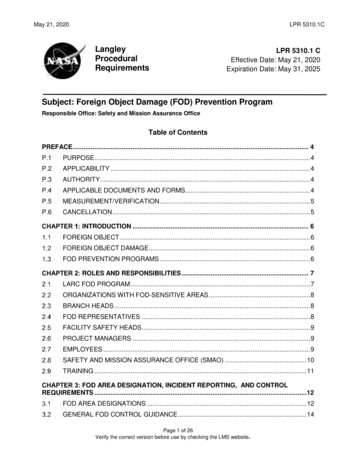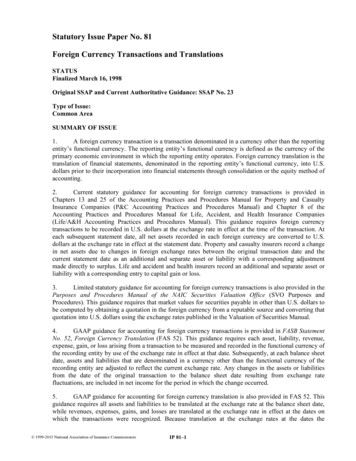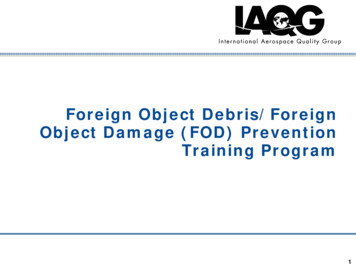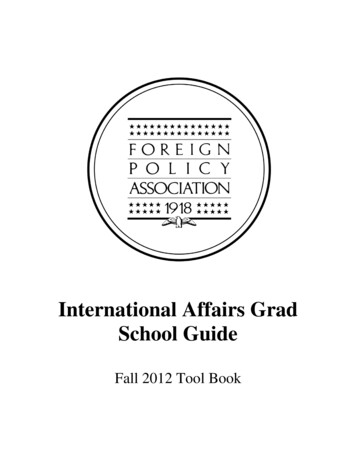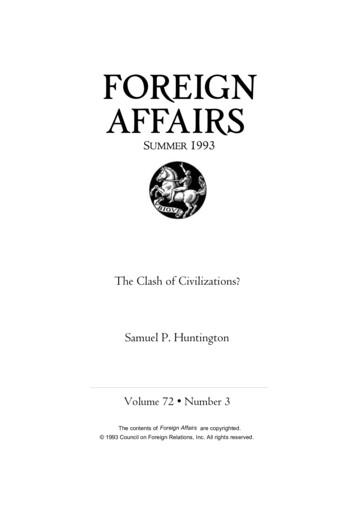
Transcription
FOREIGNAFFAIRSSUMMER 1993The Clash of Civilizations?Samuel P. HuntingtonVolume 72 Number 3The contents of Foreign Affairs are copyrighted. 1993 Council on Foreign Relations, Inc. All rights reserved.
The Clash of Civilizations?Samuel P. HuntingdonTHE NEXT PATTERN OF CONFLICTWORLD POLITICS is entering a new phase, and intellectuals havenot hesitated to proliferate visions of what it will be—the end of history, the return of traditional rivalries between nation states, and thedecline of the nation state from the conflicting pulls of tribalism andglobalism, among others. Each of these visions catches aspects of theemerging reality. Yet they all miss a crucial, indeed a central, aspectof what global politics is likely to be in the coming years.It is my hypothesis that the fundamental source of conflict in thisnew world will not be primarily ideological or primarily economic.The great divisions among humankind and the dominating source ofconflict will be cultural. Nation states will remain the most powerfulactors in world affairs, but the principal conflicts of global politics willoccur between nations and groups of different civilizations. The clashof civilizations will dominate global politics. The fault lines betweencivilizations will be the battle lines of the future.Conflict between civilizations will be the latest phase in the evolution of conflict in the modern world. For a century and a half afterthe emergence of the modern international system with the Peace ofWestphalia, the conflicts of the Western world were largely amongSAMUEL P. HUNTINGTON is the Eaton Professor of the Science ofGovernment and Director of the John M. Olin Institute for StrategicStudies at Harvard University. This article is the product of the OlinInstitute's project on "The Changing Security Environment andAmerican National Interests."[22]
The Clash of Civilizations?princes—emperors, absolute monarchs and constitutional monarchsattempting to expand their bureaucracies, their armies, their mercantilist economic strength and, most important, the territory theyruled. In the process they created nation states, and beginning withthe French Revolution the principal lines of conflict were betweennations rather than princes. In 1793, as R. R. Palmer put it, "The warsof kings were over; the wars of peoples had begun." This nineteenthcentury pattern lasted until the end of World War I. Then, as a resultof the Russian Revolution and the reaction against it, the conflict ofnations yielded to the conflict of ideologies, first among communism,fascism-Nazism and liberal democracy, and then between communism and liberal democracy. During the Cold War, this latter conflictbecame embodied in the struggle between the two superpowers, neither of which was a nation state in the classical European sense andeach of which defined its identity in terms of its ideology.These conflicts between princes, nation states and ideologies wereprimarily conflicts within Western civilization, "Western civil wars,"as William Lind has labeled them. This was as true of the Cold Waras it was of the world wars and the earlier wars of the seventeenth,eighteenth and nineteenth centuries. With the end of the Cold War,international politics moves out of its Western phase, and its centerpiece becomes the interaction between the West and non-Westerncivilizations and among non-Western civilizations. In the politics ofcivilizations, the peoples and governments of non-Western civilizations no longer remain the objects of history as targets of Westerncolonialism but join the West as movers and shapers of history.THE NATURE OF CIVILIZATIONSD U R I N G THE COLD WAR the world was divided into the First,Second and Third Worlds. Those divisions are no longer relevant. Itis far more meaningful now to group countries not in terms of theirpolitical or economic systems or in terms of their level of economicdevelopment but rather in terms of their culture and civilization.What do we mean when we talk of a civilization? A civilization isa cultural entity. Villages, regions, ethnic groups, nationalities, reliF O R E I G N A F F A I R S Summer i993
Samuel P. Huntingtongious groups, all have distinct cultures at different levels of culturalheterogeneity. The culture of a village in southern Italy may be different from that of a village in northern Italy, but both will share in acommon Italian culture that distinguishes them from German villages. European communities, in turn, will share cultural features thatdistinguish them from Arab or Chinese communities. Arabs,Chinese and Westerners, however, are not part of any broader cultural entity. They constitute civilizations. A civilization is thus thehighest cultural grouping of people and the broadest level of culturalidentity people have short of that which distinguishes humans fromother species. It is defined both by common objective elements, suchas language, history, religion, customs, institutions, and by the subjective self-identification of people. People have levels of identity: aresident of Rome may define himself with varying degrees of intensity as a Roman, an Italian, a Catholic, a Christian, a European, aWesterner. The civilization to which he belongs is the broadest levelof identification with which he intensely identifies. People can anddo redefine their identities and, as a result, the composition andboundaries of civilizations change.Civilizations may involve a large number of people, as with China("a civilization pretending to be a state," as Lucian Pye put it), or avery small number of people, such as the Anglophone Caribbean. Acivilization may include several nation states, as is the case withWestern, Latin American and Arab civilizations, or only one, as is thecase with Japanese civilization. Civilizations obviously blend andoverlap, and may include subcivilizations. Western civilization hastwo major variants, European and North American, and Islam has itsArab, Turkic and Malay subdivisions. Civilizations are nonethelessmeaningful entities, and while the lines between them are seldomsharp, they are real. Civilizations are dynamic; they rise and fall; theydivide and merge. And, as any student of history knows, civilizationsdisappear and are buried in the sands of time.Westerners tend to think of nation states as the principal actors inglobal affairs. They have been that, however, for only a few centuries.The broader reaches of human history have been the history of civi[24]F O R E I G N A F F A I R S Volume 72 0.3
The Clash of Civilizations?lizations. In A Study of History, Arnold Toynbee identified 21 majorcivilizations; only six of them exist in the contemporary world.WHY CIVILIZATIONS WILL CLASHCIVILIZATION IDENTITY will be increasingly important in thefuture, and the world will be shaped in large measure by the interactions among seven or eight major civilizations. These includeWestern, Confucian, Japanese, Islamic, Hindu, Slavic-Orthodox,Latin American and possibly African civilization. The most important conflicts of the future will occur along the cultural fault lines separating these civilizations from one another.Why will this be the case?First, differences among civilizations are not only real; they arebasic. Civilizations are differentiated from each other by history, language, culture, tradition and, most important,religion. The people of different civilizations nThe conflicts of thehave different views on the relations betweenGod and man, the individual and the group, the future will OCCUr alongcitizen and the state, parents and children, hus- he cultural fault linesband and wife, as well as differing views of the. M.relative importance of rights and responsibili- Separating Civilizations.ties, liberty and authority, equality and hierarchy. These differences are the product of centuries. They will notsoon disappear. They are far more fundamental than differencesamong political ideologies and political regimes. Differences do notnecessarily mean conflict, and conflict does not necessarily mean violence. Over the centuries, however, differences among civilizationshave generated the most prolonged and the most violent conflicts.Second, the world is becoming a smaller place. The interactionsbetween peoples of different civilizations are increasing; theseincreasing interactions intensify civilization consciousness andawareness of differences between civilizations and commonalitieswithin civilizations. North African immigration to France generateshostility among Frenchmen and at the same time increased receptivity to immigration by "good" European Catholic Poles. AmericansF O R E I G N A F F A I R S Summer 1993[25]
Samuel P. Huntingtonreact far more negatively to Japanese investment than to larger investments from Canada and European countries. Similarly, as DonaldHorowitz has pointed out, "An Ibo may be . an Owerri Ibo or anOnitsha Ibo in what was the Eastern region of Nigeria. In Lagos, heis simply an Ibo. In London, he is a Nigerian. In New York, he is anAfrican." The interactions among peoples of different civilizationsenhance the civilization-consciousness of people that, in turn, invigorates differences and animosities stretching or thought to stretchback deep into history.Third, the processes of economic modernization and social changethroughout the world are separating people from longstanding localidentities. They also weaken the nation state as a source of identity.In much of the world religion has moved in to fill this gap, often inthe form of movements that are labeled "fundamentalist." Suchmovements are found in Western Christianity, Judaism, Buddhismand Hinduism, as well as in Islam. In most countries and most religions the people active in fundamentalist movements are young, college-educated, middle-class technicians, professionals and businesspersons. The "unsecularization of the world," George Weigel hasremarked, "is one of the dominant social facts of life in the late twentieth century." The revival of religion, "la revanche de Dieu," as GillesKepel labeled it, provides a basis for identity and commitment thattranscends national boundaries and unites civilizations.Fourth, the growth of civilization-consciousness is enhanced bythe dual role of the West. On the one hand, the West is at a peak ofpower. At the same time, however, and perhaps as a result, a returnto the roots phenomenon is occurring among non-Western civilizations. Increasingly one hears references to trends toward a turninginward and "Asianization" in Japan, the end of the Nehru legacy andthe "Hinduization" of India, the failure of Western ideas of socialismand nationalism and hence "re-Islamization" of the Middle East, andnow a debate over Westernization versus Russianization in BorisYeltsins country. A West at the peak of its power confronts nonWests that increasingly have the desire, the will and the resources toshape the world in non-Western ways.In the past, the elites of non-Western societies were usually the[26]F O R E I G N A F F A I R S Volume72 No.j
The Clash of Civilizations?people who were most involved with the West, had been educated atOxford, the Sorbonne or Sandhurst, and had absorbed Western attitudes and values. At the same time, the populace in non-Westerncountries often remained deeply imbued with the indigenous culture.Now, however, these relationships are being reversed. A deWesternization and indigenization of elites is occurring in many nonWestern countries at the same time that Western, usually American,cultures, styles and habits become more popular among the mass ofthe people.Fifth, cultural characteristics and differences are less mutable andhence less easily compromised and resolved than political and economic ones. In the former Soviet Union, communists can becomedemocrats, the rich can become poor and the poor rich, but Russianscannot become Estonians and Azeris cannot become Armenians. Inclass and ideological conflicts, the key question was "Which side areyou on?" and people could and did choose sides and change sides. Inconflicts between civilizations, the question is "What are you?" Thatis a given that cannot be changed. And as we know, from Bosnia tothe Caucasus to the Sudan, the wrong answer to that question canmean a bullet in the head. Even more than ethnicity, religion discriminates sharply and exclusively among people. A person can behalf-French and half-Arab and simultaneously even a citizen of twocountries. It is more difficult to be half-Catholic and half-Muslim.Finally, economic regionalism is increasing. The proportions oftotal trade that were intraregional rose between 1980 and 1989 from51 percent to 59 percent in Europe, 33 percent to 37 percent in EastAsia, and 32 percent to 36 percent in North America. The importanceof regional economic blocs is likely to continue to increase in thefuture. On the one hand, successful economic regionalism will reinforce civilization-consciousness. On the other hand, economicregionalism may succeed only when it is rooted in a common civilization. The European Community rests on the shared foundationof European culture and Western Christianity. The success of theNorth American Free Trade Area depends on the convergence nowunderway of Mexican, Canadian and American cultures. Japan, incontrast, faces difficulties in creating a comparable economic entityF O R E I G N A F F A I R S - Summer 1993[27]
Samuel P. Huntingtonin East Asia because Japan is a society and civilization unique to itself.However strong the trade and investment links Japan may developwith other East Asian countries, its cultural differences with thosecountries inhibit and perhaps preclude its promoting regional economic integration like that in Europe and North America.Common culture, in contrast, is clearly facilitating the rapidexpansion of the economic relations between the People s Republic ofChina and Hong Kong, Taiwan, Singapore and the overseas Chinesecommunities in other Asian countries. With the Cold War over, cultural commonalities increasingly overcome ideological differences,and mainland China and Taiwan move closer together. If culturalcommonality is a prerequisite for economic integration, the principalEast Asian economic bloc of the future is likely to be centered onChina. This bloc is, in fact, already coming into existence. As MurrayWeidenbaum has observed,Despite the current Japanese dominance of the region, the Chinese-basedeconomy of Asia is rapidly emerging as a new epicenter for industry, commerce and finance. This strategic area contains substantial amounts of technology and manufacturing capability (Taiwan), outstanding entrepreneurial,marketing and services acumen (Hong Kong), a fine communications network (Singapore), a tremendous pool of financial capital (all three), and verylarge endowments of land, resources and labor (mainland China). FromGuangzhou to Singapore, from Kuala Lumpur to Manila, this influential network1—often based on extensions of the traditional clans—has been describedas the backbone of the East Asian economy.1Culture and religion also form the basis of the EconomicCooperation Organization, which brings together ten non-ArabMuslim countries: Iran, Pakistan, Turkey, Azerbaijan, Kazakhstan,Kyrgyzstan, Turkmenistan, Tadjikistan, Uzbekistan and Afghanistan. One impetus to the revival and expansion of this organization,founded originally in the 19608 by Turkey, Pakistan and Iran, is therealization by the leaders of several of these countries that they hadno chance of admission to the European Community. Similarly,Caricom, the Central American Common Market and Mercosur resthurray Weidenbaum, Greater China: The Next Economic Superpower?, St. Louis:Washington University Center for the Study of American Business, ContemporaryIssues, Series 57, February 1993, pp. 2-3.[28]F O R E I G N AFFAIRS Volume 72 0.3
The Clash of Civilizations?on common cultural foundations. Efforts to build a broaderCaribbean-Central American economic entity bridging the AngloLatin divide, however, have to date failed.As people define their identity in ethnic and religious terms, theyare likely to see an "us" versus "them" relation existing between themselves and people of different ethnicity or religion. The end of ideologically defined states in Eastern Europe and the former SovietUnion permits traditional ethnic identities and animosities to cometo the fore. Differences in culture and religion create differences overpolicy issues, ranging from human rights to immigration to trade andcommerce to the environment. Geographical propinquity gives riseto conflicting territorial claims from Bosnia to Mindanao. Mostimportant, the efforts of the West to promote its values of democracy and liberalism as universal values, to maintain its military predominance and to advance its economic interests engendercountering responses from other civilizations. Decreasingly able tomobilize support and form coalitions on the basis of ideology, governments and groups will increasingly attempt to mobilize support byappealing to common religion and civilization identity.The clash of civilizations thus occurs at two levels. At the microlevel, adjacent groups along the fault lines between civilizationsstruggle, often violently, over the control of territory and each other.At the macro-level, states from different civilizations compete for relative military and economic power, struggle over the control of international institutions and third parties, and competitively promotetheir particular political and religious values.THE FAULT L I N E S BETWEEN CIVILIZATIONSTHE FAULT LINES between civilizations are replacing the politicaland ideological boundaries of the Cold War as the flash points for crisis and bloodshed. The Cold War began when the Iron Curtaindivided Europe politically and ideologically. The Cold War endedwith the end of the Iron Curtain. As the ideological division ofEurope has disappeared, the cultural division of Europe betweenWestern Christianity, on the one hand, and Orthodox ChristianityF O R E I G N A F F A I R S Summer i993[29]
Samuel P. HuntingtonMLA-SIA tPOLANDN -Jif. . JC" S ffi wiraf i[303and Islam, on the other, has reemerged.The most significant dividing line inEurope, as William Wallace has suggested,may well be the eastern boundary ofWestern Christianity in the year 1500. Thisline runs along what are now the boundariesbetween Finland and Russia and betweenthe Baltic states and Russia, cuts throughBelarus and Ukraine separating the moreCatholic western Ukraine from Orthodoxeastern Ukraine, swings westward separating Transylvania from the rest of Romania,and then goes through Yugoslavia almostexactly along the line now separatingCroatia and Slovenia from the rest ofYugoslavia. In the Balkans this line, ofcourse, coincides with the historic boundary between the Hapsburg and Ottomanempires. The peoples to the north and westof this line are Protestant or Catholic; theyshared the common experiences of European history—feudalism, the Renaissance,the Reformation, the Enlightenment, theFrench Revolution, the Industrial Revolution; they are generally economically better off than the peoples to the east; and theymay now look forward to increasinginvolvement in a common European economy and to the consolidation of democratic political systems. The peoples to the eastand south of this line are Orthodox orMuslim; they historically belonged to theOttoman or Tsarist empires and were onlylightly touched by the shaping events in therest of Europe; they are generally lessadvanced economically; they seem muchF O R E I G N A F F A I R S Volume72Noj
The Clash of Civilizations'?less likely to develop stable democratic political systems. The VelvetCurtain of culture has replaced the Iron Curtain of ideology as themost significant dividing line in Europe. As the events in Yugoslaviashow, it is not only a line of difference; it is also at times a line ofbloody conflict.Conflict along the fault line between Western and Islamic civilizations has been going on for 1,300 years. After the founding ofIslam, the Arab and Moorish surge west and north only ended atTours in 732. From the eleventh to the thirteenth century theCrusaders attempted with temporary success to bring Christianityand Christian rule to the Holy Land. From the fourteenth to the seventeenth century, the Ottoman Turks reversed the balance, extendedtheir sway over the Middle East and the Balkans, capturedConstantinople, and twice laid siege to Vienna. In the nineteenth andearly twentieth centuries as Ottoman power declined Britain, France,and Italy established Western control over most of North Africa andthe Middle East.After World War II, the West, in turn, began to retreat; the colonial empires disappeared; first Arab nationalism and then Islamicfundamentalism manifested themselves; the West became heavilydependent on the Persian Gulf countries for its energy; the oil-richMuslim countries became money-rich and, when they wished to,weapons-rich. Several wars occurred between Arabs and Israel (created by the West). France fought a bloody and ruthless war in Algeriafor most of the 19505; British and French forces invaded Egypt in1956; American forces went into Lebanon in 1958; subsequentlyAmerican forces returned to Lebanon, attacked Libya, and engagedin various military encounters with Iran; Arab and Islamic terrorists,supported by at least three Middle Eastern governments, employedthe weapon of the weak and bombed Western planes and installationsand seized Western hostages. This warfare between Arabs and theWest culminated in 1990, when the United States sent a massive armyto the Persian Gulf to defend some Arab countries against aggressionby another. In its aftermath NATO planning is increasingly directed topotential threats and instability along its "southern tier."This centuries-old military interaction between the West andF O R E I G N A F F A I R S - Summer 1993[31]
Samuel P. HuntingtonIslam is unlikely to decline. It could become more virulent. The GulfWar left some Arabs feeling proud that Saddam Hussein hadattacked Israel and stood up to the West. It also left many feelinghumiliated and resentful of the West's military presence in thePersian Gulf, the West's overwhelming military dominance, andtheir apparent inability to shape their own destiny. Many Arab countries, in addition to the oil exporters, are reaching levels of economicand social development where autocratic forms of governmentbecome inappropriate and efforts to introduce democracy becomestronger. Some openings in Arab political systems have alreadyoccurred. The principal beneficiaries of these openings have beenIslamist movements. In the Arab world, in short, Western democracy strengthens anti-Western political forces. This may be a passingphenomenon, but it surely complicates relations between Islamiccountries and the West.Those relations are also complicated by demography. The spectacular population growth in Arab countries, particularly in NorthAfrica, has led to increased migration to Western Europe. The movement within Western Europe toward minimizing internal boundaries has sharpened political sensitivities with respect to thisdevelopment. In Italy, France and Germany, racism is increasinglyopen, and political reactions and violence against Arab and Turkishmigrants have become more intense and more widespread since 1990.On both sides the interaction between Islam and the West is seenas a clash of civilizations. The West's "next confrontation," observesM. J. Akbar, an Indian Muslim author, "is definitely going to comefrom the Muslim world. It is in the sweep of the Islamic nations fromthe Maghreb to Pakistan that the struggle for a new world order willbegin." Bernard Lewis comes to a similar conclusion:We are facing a mood and a movement far transcending the level of issues andpolicies and the governments that pursue them. This is no less than a clash ofcivilizations—the perhaps irrational but surely historic reaction of an ancientrival against our Judeo-Christian heritage, our secular present, and the worldwide expansion of both.22Bernard Lewis, "The Roots of Muslim Rage," The Atlantic Monthly, vol. 266,September 1990, p. 60; Time, June 15,1992, pp. 24-28.[32]F O R E I G N A F F A I R S - Volume72No.j
The Clash of Civilizations?Historically, the other great antagonistic interaction of ArabIslamic civilization has been with the pagan, animist, and nowincreasingly Christian black peoples to the south. In the past, thisantagonism was epitomized in the image of Arab slave dealers andblack slaves. It has been reflected in the on-going civil war in theSudan between Arabs and blacks, the fighting in Chad betweenLibyan-supported insurgents and the government, the tensionsbetween Orthodox Christians and Muslims in the Horn of Africa,and the political conflicts, recurring riots and communal violencebetween Muslims and Christians in Nigeria. The modernization ofAfrica and the spread of Christianity are likely to enhance the probability of violence along this fault line. Symptomatic of the intensification of this conflict was the Pope John Paul IPs speech inKhartoum in February 1993 attacking the actions of the Sudan'sIslamist government against the Christian minority there.On the northern border of Islam, conflict has increasingly erupted between Orthodox and Muslim peoples, including the carnage ofBosnia and Sarajevo, the simmering violence between Serb andAlbanian, the tenuous relations between Bulgarians and theirTurkish minority, the violence between Ossetians and Ingush, theunremitting slaughter of each other by Armenians and Azeris, thetense relations between Russians and Muslims in Central Asia, andthe deployment of Russian troops to protect Russian interests in theCaucasus and Central Asia. Religion reinforces the revival of ethnicidentities and restimulates Russian fears about the security of theirsouthern borders. This concern is well captured by Archie Roosevelt:Much of Russian history concerns the struggle between the Slavs and theTurkic peoples on their borders, which dates back to the foundation of theRussian state more than a thousand years ago. In the Slavs' millennium-longconfrontation with their eastern neighbors lies the key to an understandingnot only of Russian history, but Russian character. To understand Russianrealities today one has to have a concept of the great Turkic ethnic group thathas preoccupied Russians through the centuries.3The conflict of civilizations is deeply rooted elsewhere in Asia.The historic clash between Muslim and Hindu in the subcontinent3Archie Roosevelt, ForLust of Knowing, Boston: Little, Brown, 1988, pp. 332-333.F O R E I G N A F F A I R S Summer 1993[33]
Samuel P. Huntingtonmanifests itself now not only in the rivalry between Pakistan andIndia but also in intensifying religious strife within India betweenincreasingly militant Hindu groups and India's substantial Muslimminority. The destruction of the Ayodhya mosque in December 1992brought to the fore the issue of whether India will remain a seculardemocratic state or become a Hindu one. In East Asia, China hasoutstanding territorial disputes with most of itsshanedneighbors. It has pursued a ruthless policytoward the Buddhist people of Tibet, and it isIslamic blOC, irom tnepursuing an increasingly ruthless policy towardbulge of Africa tO*ts Turkic-Muslim minority. With the Cold!A . iWar over, the underlying differences betweencentral Asia, hasChina and the United States have reassertedbloody borders.themselves in areas such as human rights, tradeand weapons proliferation. These differencesare unlikely to moderate. A "new cold war/' Deng Xaioping reportedly asserted in 1991, is under way between China and America.The same phrase has been applied to the increasingly difficult relations between Japan and the United States. Here cultural differenceexacerbates economic conflict. People on each side allege racism onthe other, but at least on the American side the antipathies are notracial but cultural. The basic values, attitudes, behavioral patterns ofthe two societies could hardly be more different. The economic issuesbetween the United States and Europe are no less serious than thosebetween the United States and Japan, but they do not have the samepolitical salience and emotional intensity because the differencesbetween American culture and European culture are so much lessthan those between American civilization and Japanese civilization.The interactions between civilizations vary greatly in the extent towhich they are likely to be characterized by violence. Economic competition clearly predominates between the American and Europeansubcivilizations of the West and between both of them and Japan. Onthe Eurasian continent, however, the proliferation of ethnic conflict,epitomized at the extreme in "ethnic cleansing," has not been totallyrandom. It has been most frequent and most violent between groupsbelonging to different civilizations. In Eurasia the great historic fault[34]F O R E I G N AFFAIRS - Volume72 No.j
The Clash of Civilizations'?lines between civilizations are once more aflame. This is particularlytrue along the boundaries of the crescent-shaped Islamic bloc ofnations from the bulge of Africa to central Asia. Violence also occursbetween Muslims, on the one hand, and Orthodox Serbs in theBalkans, Jews in Israel, Hindus in India, Buddhists in Burma andCatholics in the Philippines. Islam has bloody borders.CIVILIZATION RALLYING: THE KIN-COUNTRY SYNDROMEGROUPS OR STATES belonging to one civilization that become involved in war with people from a different civilization naturally try torally support from other members of their own civilization. As thepost-Cold War world evolves, civilization commonality, what H. D.S. Greenway has termed the "kin-country" syndrome, is replacingpolitic
The Clash of Civilizations? Samuel P. Huntingdon THE NEXT PATTERN OF CONFLICT WORLD POLITICS is entering a new phase, and intellectuals have . SAMUEL P. HUNTINGTON is the Eaton Professor of the Science of Government and Director of the John M. Olin Institute for Strategic Studies at Harvard University. This article is the product of the Olin

